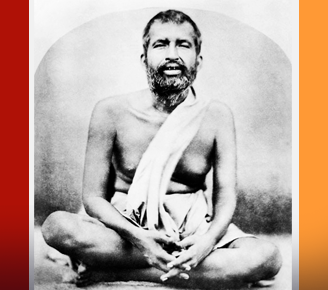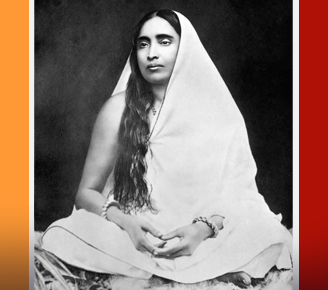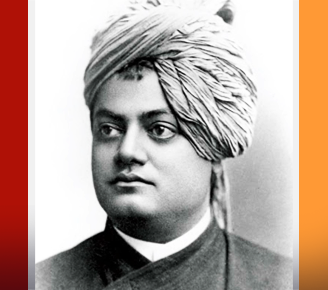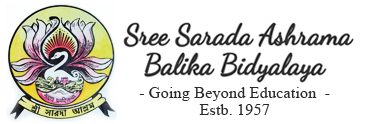

SRI RAMAKRISHNA:
Sri Ramakrishna was born on 18th February 1836 in the village of Kamarpukur about sixty miles northwest of Kolkata. His parents, Kshudiram Chattopadhyaya and Chandramani Devi, were poor but very pious and virtuous. As a child, Ramakrishna (his childhood name was Gadadhar) was dearly loved by the villagers. From early days, he was disinclined towards formal education and worldly affairs. He was, however, a talented boy, and could sing and paint well. He was fond of serving holy men and listening to their discourses. He was also very often found to be absorbed in spiritual moods. At the age of six, he experienced the first ecstasy while watching a flight of white cranes moving against the background of black clouds. This tendency to enter into ecstasy intensified with age. His father’s death when he was seven years old served only to deepen his introspection and increase his detachment from the world.

As a Priest at Dakshineswar Temple Sri Ramakrishna:
When Sri Ramakrishna was sixteen, his brother Ramkumar took him to Kolkata to assist him in his priestly profession. In 1855 the Kali Temple at Dakshineswar built by Rani Rasmani was consecrated and Ramkumar became the chief priest in that temple. When he died a few months later, Ramakrishna was appointed the priest. Ramakrishna developed intense devotion to Mother Kali and spent hours in loving adoration of her image, forgetting the rituals of priestly duties. His intense longing culminated in the vision of Mother Kali as boundless effulgence engulfing everything around him.
Intense Spiritual Practices:
Sri Ramakrishna’s God-intoxicated state alarmed his relatives in Kamarpukur and they got him married to Saradamani, a girl from the neighbouring village of Jayrambati. Unaffected by the marriage, Sri Ramakrishna plunged into even more intense spiritual practices. Impelled by a strong inner urge to experience different aspects of God he followed, with the help of a series of Gurus, the various paths described in the Hindu scriptures, and realized God through each of them. The first teacher to appear at Dakshineswar (in 1861) was a remarkable woman known as Bhairavi Brahmani who was an advanced spiritual adept, well versed in scriptures. With her help Sri Ramakrishna practised various difficult disciplines of the Tantrik path, and attained success in all of them. Three years later came a wandering monk by name Totapuri, under whose guidance Sri Ramakrishna attained Nirvikalpa Samadhi, the highest spiritual experience mentioned in the Hindu scriptures. He remained in that state of non-dual existence for six months without the least awareness of even his own body. In this way, Sri Ramakrishna relived the entire range of spiritual experiences of more than three thousand years of Hindu religion.
Worshipping His Wife:
In 1872, his wife Sarada, now nineteen years old, came from the village to meet him. He received her cordially, and taught her how to attend to household duties and at the same time lead an intensely spiritual life. One night he worshipped her as the Divine Mother in his room at the Dakshineswar temple. Although Sarada continued to stay with him, they lived immaculately pure lives, and their marital relationship was purely spiritual. It should be mentioned here that Sri Ramakrishna had been ordained a Sannyasin (Hindu monk), and he observed the basic vows of a monk to perfection. But outwardly he lived like a lay man, humble, loving and with childlike simplicity. During Sri Ramakrishna’s stay at Dakshineswar, Rani Rasmani first acted as his patron. After her death, her son-in-law Mathur Nath Biswas took care of his needs.
The Gospel of Sri Ramakrishna:
Sri Ramakrishna did not write any book, nor did he deliver public lectures. Instead, he chose to speak in a simple language using parables and metaphors by way of illustration, drawn from the observation of nature and ordinary things of daily use. His conversations were charming and attracted the cultural elite of Bengal. These conversations were noted down by his disciple Mahendranath Gupta who published them in the form of a book, Sri Sri Ramakrishna Kathamrita in Bengali. Its English rendering, The Gospel of Sri Ramakrishna, was released in 1942; it continues to be increasingly popular to this day on account of its universal appeal and relevance.
Last Days:
The intensity of his spiritual life and untiring spiritual ministration to the endless stream of seekers told on Sri Ramakrishna’s health. He developed cancer of the throat in 1885. He was shifted to a spacious suburban villa where his young disciples nursed him day and night. He instilled in them love for one another, and thus laid the foundation for the future monastic brotherhood known as Ramakrishna Math. In the small hours of 16th August 1886 Sri Ramakrishna gave up his physical body, uttering the name of the Divine Mother, and passed into Eternity.

SREE SREE SARADAMONI DEVI:
Holy Mother, Sri Sarada Devi, the spiritual consort of Sri Ramakrishna, was born on 22 December 1853 in a poor Brahmin family in Jayrambati, a village adjoining Kamarpukur in West Bengal. Her father, Ramachandra Mukhopadhyay, was a pious and kind-hearted person, and her mother, Shyama Sundari Devi, was a loving and hard-working woman.
Marriage:
As a child Sarada was devoted to God, and spent most of her time helping her mother in various household errands. She had no formal schooling, but managed to learn the Bengali alphabet. When she was about six years old, she was married to Sri Ramakrishna. However, after the event, she continued to live with her parents, while Sri Ramakrishna lived a God-intoxicated life at Dakshineshwar.
Visit to Dakshineshwar:
At the age of eighteen she walked all the way to Dakshineshwar to meet her husband. Sri Ramakrishna, received her with great affection, and allowed her to stay with him. He taught her how to lead a spiritual life while discharging her household duties. They led absolutely pure lives, and Sarada Devi served Sri Ramakrishna as his devoted wife and disciple, while remaining a virgin nun and following the spiritual path.
Life at Dakshineshwar:
Sri Ramakrishna looked upon Sarada Devi as a special manifestation of Divine Mother of the universe. In 1872, on the night of the Phala-harini-Kali-puja, he ritualistically worshipped Sarada Devi as the Divine Mother, thereby awakening universal Motherhood latent in her. When disciples began to gather around Sri Ramakrishna, Sarada Devi learned to look upon them as her own children. The room in which she stayed at Dakshineshwar was too small to live in and had hardly any amenities; and on many days she did not get the opportunity of meeting Sri Ramakrishna. But she bore all difficulties silently and lived in contentment and peace, serving the increasing number of devotees who came to see Sri Ramakrishna.
Leading the Sangha after the Master’s Passing:
After Sri Ramakrishna’s passing away in 1886, Sarada Devi spent some months in pilgrimage, and then went to Kamarpukur where she lived in great privation. Coming to know of this, the disciples of Sri Ramakrishna brought her to Kolkata. This marked a turning point in her life. She now began to accept spiritual seekers as her disciples, and became the open portal to immortality for hundreds of people. Her great universal mother-heart, endowed with boundless love and compassion, embraced all people without any distinction, including many who had lived sinful lives.
When the Western women disciples of Swami Vivekananda came to Kolkata, the Holy Mother accepted them with open arms as her daughters, ignoring the restrictions of the orthodox society of those days. Although she had grown up in a conservative rural society without any access to modern education, she held progressive views, and whole-heartedly supported Swami Vivekananda in his plans for rejuvenation of India and the uplift of the masses and women. She was closely associated with the school for girls started by Sister Nivedita.
She spent her life partly in Kolkata and partly in her native village Jayrambati. During the early years of her stay in Kolkata, her needs were looked after by Swami Yogananda, a disciple of Sri Ramakrishna. In later years her needs were looked after by another disciple of Sri Ramakrishna, Swami Saradananda, who built a new house for her in Kolkata.
Simplicity and Forbearance:
Although she was highly venerated for her spiritual status, and literally worshipped as the Divine Mother, she continued to live like a simple village mother, washing clothes, sweeping the floor, bringing water from the pond, dressing vegetables, cooking and serving food. At Jayrambati she lived with her brothers and their families. They gave her endless troubles but, established as she was in the awareness of God and in Divine Motherhood, she always remained calm and self-possessed, showering love and blessings on all who came into contact with her. As Sister Nivedita stated, “Her life was one long stillness of prayer.”
Mother of All:
In the history of humanity there has never been another woman who looked upon herself as the Mother of all beings, including animals and birds, and spent her whole life in serving them as her children, undergoing unending sacrifice and self-denial. About her role in the mission of Sri Ramakrishna on earth, she stated: “My son, you know the Master had a maternal attitude (matri-bhava) towards every one. He has left me behind to manifest that Divine Motherhood in the world.”
Ideal Woman:
On account of her immaculate purity, extraordinary forbearance, selfless service, unconditional love, wisdom and spiritual illumination, Swami Vivekananda regarded Sri Sarada Devi as the ideal for women in the modern age. He believed that with the advent of Holy Mother, the spiritual awakening of women in modern times had begun.
LastDays:
Under the strain of constant physical work and self-denial and repeated attacks of malaria, her health deteriorated in the closing years of her life, and she left the mortal world on 21st July 1920.
Teachings and quotes:
Sarada Devi did not write any books; her utterances and reminiscences have been recorded by her disciples including Swami Nikhilananda, Swami Tapasyananda.Though uneducated Sarada Devi’s spiritual insight and utterances are highly regarded by scholars like Gayatri Chakravorty Spivak, who writes, “We have bits and pieces of her exquisite remarks as testimony.
Practise meditation, and by and by your mind will be so calm and fixed that you will find it hard to keep away from meditation.
The mind is everything. It is in the mind alone that one feels pure and impure. A man, first of all, must make his own mind guilty and then alone can he see another man’s guilt.
“I tell you one thing. If you want peace of mind, do not find fault with others. Rather see your own faults. Learn to make the whole world your own. No one is a stranger, my child; the whole world is your own.
One must have devotion towards one’s own guru. Whatever may be the nature of the guru, the disciple gets salvation by dint of his unflinching devotion towards his guru.
SWAMI VIVEKANANDA:
Swami Vivekananda, an Indian Hindu monk was born on 12th January, 1863 into an aristocratic Bengali family in Kolkata. His father, Vishwanath Datta, was a successful attorney and his mother, Bhuvaneshwari Devi, was endowed with deep devotion, strong character and other qualities. In his pre-monastic life he was known as Narendranath Datta. He graduated from Calcutta University, he had acquired a vast knowledge of different subjects, especially Western philosophy and history. Born with a yogic temperament, he used to practise meditation even from his boyhood, and was associated with Brahmo Movement for some time.
Swami Vivekananda was a key figure in the introduction of the Indian philosophies to the Western world and an inspiration for youth around the world for over a century. The valiant monk who proclaimed in America the greatness of Hinduism and of Indian culture at a time when the West regarded India as a land of barbarians. He had travelled to America as a representative of Hinduism and the ancient Indian tradition of Vedanta. Yet Vivekananda was not bound by any formal ties of religion; to the World Parliament of Religions he offered a message of a shared spirituality and the harmony of world religions. This universal message and his dynamic spiritual personality won the hearts and minds of many seekers.

He met Sri Ramakrishna at the Dakshineswar Kali temple in 1881. Many disciples gathered around Sree Ramakrishna Paramahamsa but he was the chief and the most beloved disciple of Ramakrishna. People around Ramakrishna did not understand why he was so mad about Vivekananda. Ramakrishna recognised the spiritual potential of Vivekananda and lavished attention on Vivekananda, who at first did not always understand this. In the beginning the reasoning mind of Vivekananda was sceptical of this God intoxicated Saint, and frequently question and debate his teachings. The spiritual magnetism of Sri Ramakrishna and his pure, unselfish love soon melted Vivekananda’s heart and he began to experience the real spirituality that Ramakrishna exuded.
After the passing of Ramakrishna, the other disciples looked to Vivekananda for leadership and he helped form the first monastic order of Ramakrishna. Under his leadership they formed a new monastic brotherhood, and in 1887 they took the formal vows of sannyasa thereby assuming new names thus Narendranath became Swami Vivekananda.
Swami Vivekananda was chosen to represent Hinduism at the Parliament of World Religions. However Swami Vivekananda did not try in any way to prove the superiority of his religion. Instead Vivekananda spoke with great sincerity about the harmony of world religions and the common spirituality of humanity. It was this universal message of oneness which captivated the audience. In America Vivekananda also began training some close students so they could propagate the teachings of Vedanta. He was able to start small centres in both the US and Great Britain. Vivekananda admitted he entered Britain with deep misgivings since his heart rebelled at the effects of the British Empire on his beloved Motherland. However he was delighted to find some individuals who were sincerely attracted to the teachings of Vedanta. Miss Margaret Noble (Sister Nivedita) from Ireland, became a devoted disciple of Swamiji and later dedicated her life to the Indian people.
Vivekananda returned to India where he was met with a rapturous reception. Despite falling health Vivekananda threw himself into a whirlpool of activity reorganising the monasteries and exhorting his fellow Indians to return to the truth of the Vedantic principles. As well as teaching the benefits of selfless service and encouraging greater dynamism, he also never lost sight of the ultimate goal in life, which was to become one with God.
On 4th July 1902, Vivekananda passed away at the young age of 39 but he achieved a remarkable amount in this short time on earth. Towards the end of his life, Vivekananda retreated from public service and contemplated the vaster meaning of life. He combined the ancient spiritual traditions of India with the dynamism of the West. Vivekananda is regarded as the patron saint of modern India.

